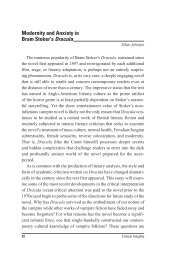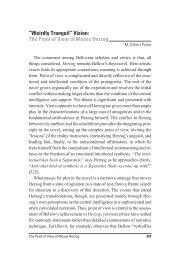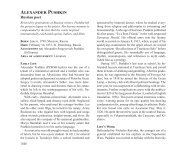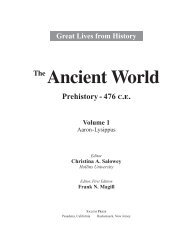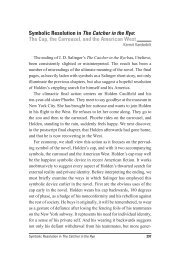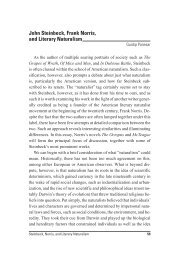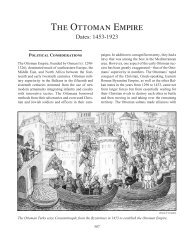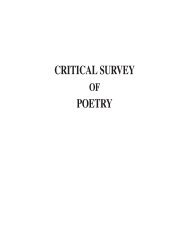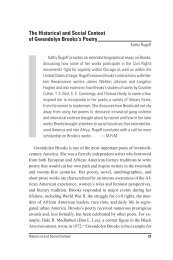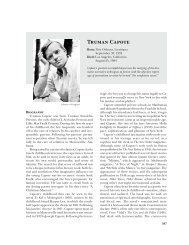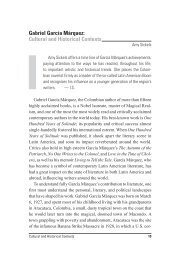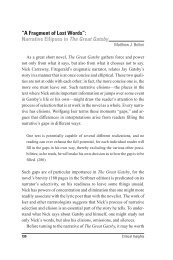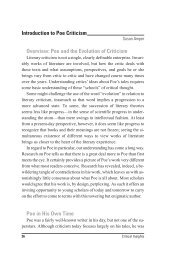Heracles's twelve labors - Salem Press
Heracles's twelve labors - Salem Press
Heracles's twelve labors - Salem Press
You also want an ePaper? Increase the reach of your titles
YUMPU automatically turns print PDFs into web optimized ePapers that Google loves.
Heracles’s Twelve Labors │ 81<br />
fragments, she reminds her readers that such revision of<br />
classic myths is not a betrayal of the originals but rather<br />
a continuation of an ancient tradition in which writers<br />
keep stories alive by telling them in new ways.<br />
This sense of connection through revision, of understanding<br />
the past by engaging with the contemporary<br />
world, resonates throughout Autobiography of Red. A<br />
large array of myths and legends have persisted through<br />
the centuries, and while figures such as Heracles seem<br />
to dominate these cultural traditions, unchanged after<br />
all that time, they are in actuality always remade, their<br />
narratives and meanings shifting. When the Herakles of<br />
Autobiography of Red brags that he is “a master of monsters”<br />
(129), the meaning of his declaration is heightened<br />
and complicated by humankind’s many cultural<br />
legacies. What does it mean to hold power over another<br />
person, whether through physical strength or emotional<br />
dependency? How do humans make monsters out of<br />
one another, and when does the monster actually deserve<br />
sympathy and understanding? Who is the hero:<br />
the dashing and powerful warrior, the sensitive and kind<br />
monster, or both? Questions such as these, nestled at the<br />
heart of the <strong>labors</strong> of the Heracles, are deep and complicated<br />
enough that they draw readers in today just as<br />
they did thousands of years ago. As much as Heracles<br />
himself might seem a bundle of contradictions and Carson’s<br />
version of the myth a departure from the intent<br />
of the original narrative, it is the availability of these<br />
different interpretations that makes the legendary hero<br />
so much more than a mighty warrior with a quest for<br />
immortality.<br />
T. Fleischmann, MFA<br />
Bibliography<br />
Burkert, Walter. Greek Religion. Cambridge: Harvard<br />
UP, 1985. Print.<br />
Carson, Anne. Autobiography of Red. New York: Vintage,<br />
1999. Print.<br />
Curtis, Paul. Stesichoros’s Geryoneis. Leiden: Brill,<br />
2011. Print.<br />
Genovese, E. N. “Hercules and His Twelve Labors.”<br />
Masterplots. 4th ed. Ed. Laurence W. Mazzeno. Pasadena:<br />
<strong>Salem</strong>, 2010. Print.<br />
Hirst, Michael. Michelangelo and His Drawings. New<br />
Haven: Yale UP, 1988. Print.<br />
Miller, Geordie. “Shifting Ground.” Canadian Literature<br />
210–211 (2011): 152–67. Print.<br />
Morgan, Pauline. “Hercules and His Twelve Labors.”<br />
Cyclopedia of Literary Places. Ed. R. Kent Rasmussen.<br />
Pasadena: <strong>Salem</strong>, 2003. Print.<br />
Murray, Stuart J. “The Autobiographical Self: Phenomenology<br />
and the Limits of Narrative Self-Possession<br />
in Anne Carson’s Autobiography of Red.” English<br />
Studies in Canada 31.4 (2005): 101–22. Print.<br />
Pseudo-Apollodorus. The Library. Trans. J. G. Frazer.<br />
1921. Cambridge: Harvard UP, 1996. Print.<br />
MYTHHERO_Book.indb 81<br />
8/20/2013 2:14:02 PM



